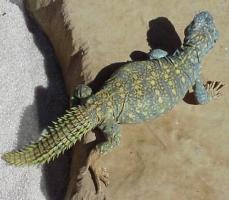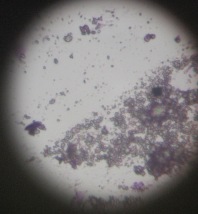Basic Care: Uromastyx
 Spiny-tailed lizards (Uromastyx spp.), also commonly referred to as Uromastyx, are among the more popular pet lizards. There are at least 14 different species of these desert-adapted lizards although only a few are being regularly imported or bred in captivity.
Spiny-tailed lizards (Uromastyx spp.), also commonly referred to as Uromastyx, are among the more popular pet lizards. There are at least 14 different species of these desert-adapted lizards although only a few are being regularly imported or bred in captivity.
The dull-colored uromastyx belong to two different species. The Egyptian uromastyx (U. aegypticus) as adults are often more than 15 inches in length with some reaching 24 inches. Some male Egyptian uromastyx may turn yellowish when warm and the females may turn white. The Indian uromastyx (U. hardwicki) is one of the more primitive forms with short rounded spines on the tail.
The more colorful uromastyx require daytime levels of high heat, bright light light, and high levels of ultraviolet-B light to show their full colors. The mali uromastyx (U. d. maliensis) and the Moroccan uromastyx (U. acanthinurus) can be yellow, green, red, orange, or a combination of colors. The Somalian uromastyx (U. macfadyeni) is blue while the Saharan or Niger uromastyx (U. gehryi) is red. Juvenile uromastyx are difficult to identify and lack the brilliant hues of the adults. Females tend to be much less colorful than males.
Most health problems are due to inappropriate husbandry conditions. A significant variation between day and night parameters is essential. Day temperature should have a hotspot that reaches 110-130°F with the cool end of the cage being 80-90°F. Night temperatures should drop to 70-80°F. Uromastyx housed indoors need heat and ultraviolet-B light provided 10-14 hours per day depending on the time of year. The photoperiod should change over the year, consistent with outside lighting, and many uromastyx benefit from a brumation period for 8-12 weeks during the winter.
The uromastyx diet should be a mix of dark green leafy vegetables and died peas, lentils, and seeds. Dark leafy greens (Romaine, escarole, kale, cabbage, turnip greens, collard greens, mustard greens, dandelion greens, cilantro should be offered several times weekly to daily. A bowl of dry split peas, lentils, small beans, and millet can be left in the cage at all times. Supplementation with calcium is essential, and can be accomplished by thoroughly mixing with the dry food prior. Multivitamin supplements should be added to the food every 1-2 weeks. Ornate and Moroccan uromastyx eat insects eagerly, and juveniles of all species may eat insects. The Egyptian uromastyx is more finicky and typically only eats plant material.
Water should be available but most uromastyx only drink from fog condensing on their bodies or from rain. Once or twice a week it is a good practice to fog a uromastyx enclosure at night with a humidifier to adequate opportunities for the lizard to drink. In the wild, they maintain their hydration by retreating to high humidity burrows or crevices (relative to the desert surface). These are lacking in most captive enclosures. Occasional soaking in a shallow pool of water may be helpful.

Gout crystals from the swollen wrist of a Uromastyx
Signs of illness include lumps and bumps in the skin and joints (often a sign of bacterial infection, gout, or nutritional secondary hyperparathyroidism), runny stools, dark dull colors, and sunken eyes. It is normal to have a ring of white crust around the nostrils as this is expelled by the salt glands inside the nose.
Unless you know this trick, you will be frustrated trying to orally medicate a uromastyx. Their jaws close extremely tightly and the teeth interdigitate in a manner that makes them very resistant to the usual tactic for opening a lizard’s mouth (i.e., inserting a speculum at the corner or tip of the jaw). However, all the commonly kept uromastyx lizards have a small gap between their two front teeth that is large enough to accommodate the passage of a small catheter. Water and liquid medications can be trickled into the mouth through this gap.

